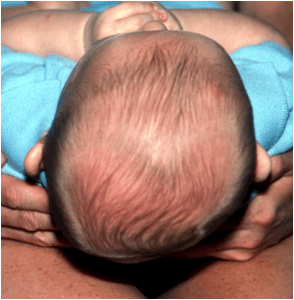Craniosynostosis Surgery
Approximately 1 out of every 1800 babies is born with an anomaly in the shape and development of the skull, making this a relatively common birth defect. Many babies have strange appearing heads at birth due to the molding that occurs in the birth canal during delivery. Often this corrects spontaneously, however sometimes parents may begin to notice some type of persistent malformation of the shape of their baby's skull or eye sockets. In these situations, parents need to talk with the baby's doctor as soon as possible so that the proper diagnosis can be obtained. At that point the various options for craniosynostosis correction can be considered.
Craniosynostosis occurs when the growth plates between the bones of your baby's skull close early. Since brain development continues in spite of this, the unaffected bones of the skull will grow disproportionately to compensate. Premature closing of the growth plates can result in an increase in pressure on the brain (ICP) and may result in serious health complications if not treated promptly. Craniosynostosis correction and cranial vault remodeling allows the baby to continue with his or her normal development without any long-term consequences.
Dr. Nicholas Bastidas, a pediatric plastic and craniofacial surgeon with advanced training in craniosynostosis surgery, has over a decade of experience in treating infant skull malformations. His outstanding credentials, coupled with his commitment to improving the lives of children and adults with visible deformities, will place your loved one in the best hands. Dr. Bastidas is widely known for his expertise in craniosynostosis surgery.
Craniosynostosis surgical treatment by Dr. Bastidas will vary, based upon the type of craniosynostosis your baby has developed. One common form of craniosynostosis is Sagittal Synostosis (Scaphocephaly), involving the bones at the top of the skull. When diagnosed early, sagittal synostosis can often be corrected using a minimally invasive endoscopic technique. Endoscopic suturectomy for sagittal synostosis allows removed the closed growth plate and remodeling of the head using a helmet after the operation. Blood loss is kept to a minimum and you can often take your baby home the next day.

The metopic growth plate (suture) lies between the bones of the forehead and is another common type of craniosynostosis. Metopic synostosis can create a triangle shaped head (trigoncephaly) and make the eyes look very close together (hypotelorism). Frontal (unicoronal) plagiocephaly involves the premature closing of the gap in the skull that goes from one ear to the other over the top of the skull. Uni-coronal craniosynostosis often causes the upper eye socket to appear deformed as well and can cause flattening on the back side of the head (trapezoid shaped head). There are other types of craniosynostosis that are less common: Bi-coronal and lambdoid. Based upon the type of craniosynostosis your baby has, there are several types of craniosynostosis surgery performed by Dr. Bastidas:
- Suture release and helmet
- Cranial vault remodeling
- Cranial vault distraction
Dr. Bastidas incorporates the latest technology into his surgical approach for correction of craniosynostosis. Significant advances in 3D printing and scanning technology have allowed for us to virtually perform the operation and plan the reconstruction before even entering the operating room. Dr. Bastidas is one of the few craniofacial surgeons incorporating this technique into cranial vault reconstruction allowing results that are precise to within 1mm of the planned reconstruction. Positioning and planning guides are 3d printed from the data obtained from the preoperative cat scan which are used to shape the bones of the skull perfectly and deliver the best aesthetic outcomes. Dr. Bastidas is an expert at using this technique and the results reflect that with better aesthetic outcomes and less anesthesia time over traditional techniques.
When you are seeking information about craniosynostosis surgery, you will learn about the work Dr. Bastidas has done in the development of the Institute of Pediatric Plastic Surgery (www.ippcs.org) and its centers of excellence including the Center for Craniosynostosis Surgery and Syndromic Craniofacial Disorders differentiates Dr. Bastidas as a pediatric plastic surgeon constantly striving to perform at the state-of-the-art level for his patients. Visit Dr. Bastidas' website at www.DrBastidas.com to learn more about the condition of craniosynostosis, craniosynostosis surgery and the steps involved in securing your baby's healthy future. We are dedicated to serving our families with the best medical care possible and strive to communicate well throughout your entire experience with us. Dr. Bastidas is committed to delivering safe, high quality care for your baby.